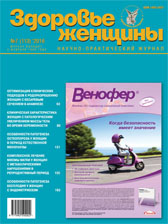Післяопераційне зниження АМГ не пов’язане зі зниженням фертильності протягом двох років після операції з приводу кіст яєчників
DOI:
https://doi.org/10.15574/100639Ключові слова:
АМГ, цистектомія, частота народження живих дітей, оваріальний резерв, хірургічне лікування кіст яєчників, результат вагітностіАнотація
У проспективному дослідженні ми досліджували вплив змін концентрації антимюллерова гормону (АМГ) після операцій з приводу кіст яєчників на ймовірність настання вагітності і народження живої дитини. Жінки репродуктивного віку (N=60) були включені в дослідження до оперативного лікування доброякісних кіст яєчників. Концентрації АМГ у сироватці крові визначали до і після операції через 6 і 24 міс. Інформацію про бажання і спроби завагітніти отримували за допомогою опитувальника. У момент включення 45/60 жінок повідомили про бажання завагітніти. На шостому місяці спостереження рівні АМГ значно знизилися у всій групі, подальше зниження спостерігали протягом двох років (від 2,7 мг/л до 2,0 мг/л і до 1,1 мг/л відповідно; р<0,008) за відсоткового зменшення 42,9%. У період дворічного спостереження 36 жінок повідомили, що намагалися завагітнити, і 18 з них завагітнили (50%) з народженням живої дитини у 33%. Відсоткова зміна у концентрації АМГ за два роки істотно не відрізнялася між жінками, які завагітніли, і тими, хто не завагітнів (р=0,117). Дані, представлені у цьому дослідженні, свідчать, що зниження рівня АМГ після операцій з приводу кіст яєчників зберігається через два роки після операції; однак це післяопераційне зниження рівня АМГ не зменшує шансів жінки завагітніти.
Ключові слова: АМГ, цистектомія, частота народження живих дітей, оваріальний резерв, хірургічне лікування кіст яєчників, результат вагітності.
Посилання
Kwon SK, Kim SH, Yun SC et al. 2014. Decline of serum antimullerian hormone levels after laparoscopic ovarian cystectomy in endome- trioma and other benign cysts: a prospective cohort study. FertilSteril. 101:435–41. http://dx.doi.org/10.1016/j.fertnstert.2013.10.043; PMid:24290000
Uncu G, Kasapoglu I, Ozerkan K et al. 2013. Prospective assessment of the impact of endometriomas and their removal on ovarian reserve and determinants of the rate of decline in ovarian reserve. Hum Reprod. 28:2140–5. http://dx.doi.org/10.1093/humrep/det123; PMid:23624580
Somigliana E, Berlanda N, Benaglia L et al. 2012. Surgical excision of endometriomas and ovarian reserve: a systematic review on serum antimu ̈llerian hormone level modifications. FertilSteril. 98:1531–8. http://dx.doi.org/10.1016/j.fertnstert.2012.08.009
Raffi F, Metwally M, Amer S. 2012. The impact of excision of ovarian endometrioma on ovarian reserve: a systematic review and meta- analysis. J ClinEndocrinolMetab. 97:3146–54. http://dx.doi.org/10.1210/jc.2012-1558; PMid:22723324
Iwase A, Hirokawa W, Goto M et al. 2011. The post-operative decline in serum anti-Mullerian hormone correlates with the bilaterality and severity of endometriosis. Hum Reprod. 26:904–10. http://dx.doi.org/10.1093/humrep/der006; PMid:21292639
Lind T, Hammarstrom M, Lampic C, Rodriguez-Wallberg K. 2015. AMH reduction after ovarian cyst surgery is dependent on the histological cyst type and pre-operative AMH levels. ActaObstetGynecolScand. 94:183–90. http://dx.doi.org/10.1111/aogs.12526; PMid:25287421
Kalampokas T, Kamath MS, Kalampokas E. 2013. AMH after laparo- scopic surgery of the ovaries: a review. GynecolEndocrinol. 29:408–11. http://dx.doi.org/10.3109/09513590.2012.754877; PMid:23452339
Moscarini M, Milazzo GN, Assorgi C et al. 2014. Ovarian stripping versus cystectomy: recurrence of endometriosis and pregnancy rate. Arch GynecolObstet. 290:163–7. http://dx.doi.org/10.1007/s00404-014-3158-z
Carmona F, Martinez-Zamora MA, Rabanal A et al. 2011. Ovarian cystectomy versus laser vaporization in the treatment of ovarian endometriomas: a randomized clinical trial with a five-year follow- up. FertilSteril. 96:251–4. http://dx.doi.org/10.1016/j.fertnstert.2011.04.068
Lind T, Lampic C, Hammarstrom M, Rodriguez-Wallberg K. 2013. Young women’s perceptions of fertility-related information and fertility distress before surgery for ovarian cysts. ActaObstetGynecolScand. 92:1290–6. http://dx.doi.org/10.1111/aogs.12228
Armuand GM, Rodriguez-Wallberg KA, Wettergren L et al. 2012. Sex differences in fertility-related information received by young adult cancer survivors. J ClinOncol. 30:2147–53. http://dx.doi.org/10.1200/JCO.2011.40.6470; PMid:22585695
Asante A, Whiteman MK, Kulkarni A et al. 2010. Elective oophorectomy in the United States: trends and in-hospital complications, 1998-2006. ObstetGynecol. 116:1088–95. http://dx.doi.org/10.1097/aog.0b013e3181f5ec9d
Statistical database, Operationerislutenva ?rd. Operations in inpatient care. Internet. 2015. Available from: http://www.socialstyrelsen.se/ statistik/statistikdatabas/operationerislutenvard. last accessed 30 Dec 2015.
Lee MM, Donahoe PK, Hasegawa T et al. 1996. Mullerian inhibiting substance in humans: normal levels from infancy to adulthood. J ClinEndocrinolMetab. 81:571–6. http://dx.doi.org/10.1210/jcem.81.2.8636269; http://dx.doi.org/10.1210/jc.81.2.571
Bentzen JG, Forman JL, Johannsen TH et al. 2013. Ovarian antral follicle subclasses and anti-mullerian hormone during normal reproductive aging. J ClinEndocrinolMetab. 98:1602–11. http://dx.doi.org/10.1210/jc.2012-1829; PMid:23463653
La Marca A, Spada E, Grisendi V et al. 2012. Normal serum anti- Mullerian hormone levels in the general female population and the relationship with reproductive history. Eur J ObstetGynecolReprodBiol. 163:180–4. http://dx.doi.org/10.1016/j.ejogrb.2012.04.013
Shao MJ, Hu M, He YQ, Xu XJ. 2015. AMH trend after laparoscopic cystectomy and ovarian suturing in patients with endometriomas. Arch GynecolObstet. [Epub ahead of print]. doi: 10.1007/ s00404-015-3926-4.
Lee HJ, Lee JE, Ku SY et al. 2013. Natural conception rate following laparoscopic surgery in infertile women with endometriosis. ClinExpReprod Med. 40:29–32. http://dx.doi.org/10.5653/cerm.2013.40.1.29
Rizk B, Turki R, Lotfy H et al. 2015. Surgery for endometriosis- associated infertility: do we exaggerate the magnitude of effect? Facts Views Vis Obgyn. 7:109–18. PMid:26177374 PMCid:PMC4498168
Vercellini P, Somigliana E, Vigano P et al. 2009. Surgery for endomet- riosis-associated infertility: a pragmatic approach. Hum Reprod. 24:254–69. http://dx.doi.org/10.1093/humrep/den379; PMid:18948311
Pados G, Venetis CA, Almaloglou K, Tarlatzis BC. 2010. Prevention of intra-peritoneal adhesions in gynaecological surgery: theory and evidence. Reprod Biomed Online. 21:290–303. http://dx.doi.org/10.1016/j.rbmo.2010.04.021; PMid:20688570
Lower AM, Hawthorn RJ, Clark D et al. 2004. Adhesion-related readmissions following gynaecological laparoscopy or laparotomy in Scotland: an epidemiological study of 24 046 patients. Hum Reprod. 19:1877–85. http://dx.doi.org/10.1093/humrep/deh321; PMid:15178659

